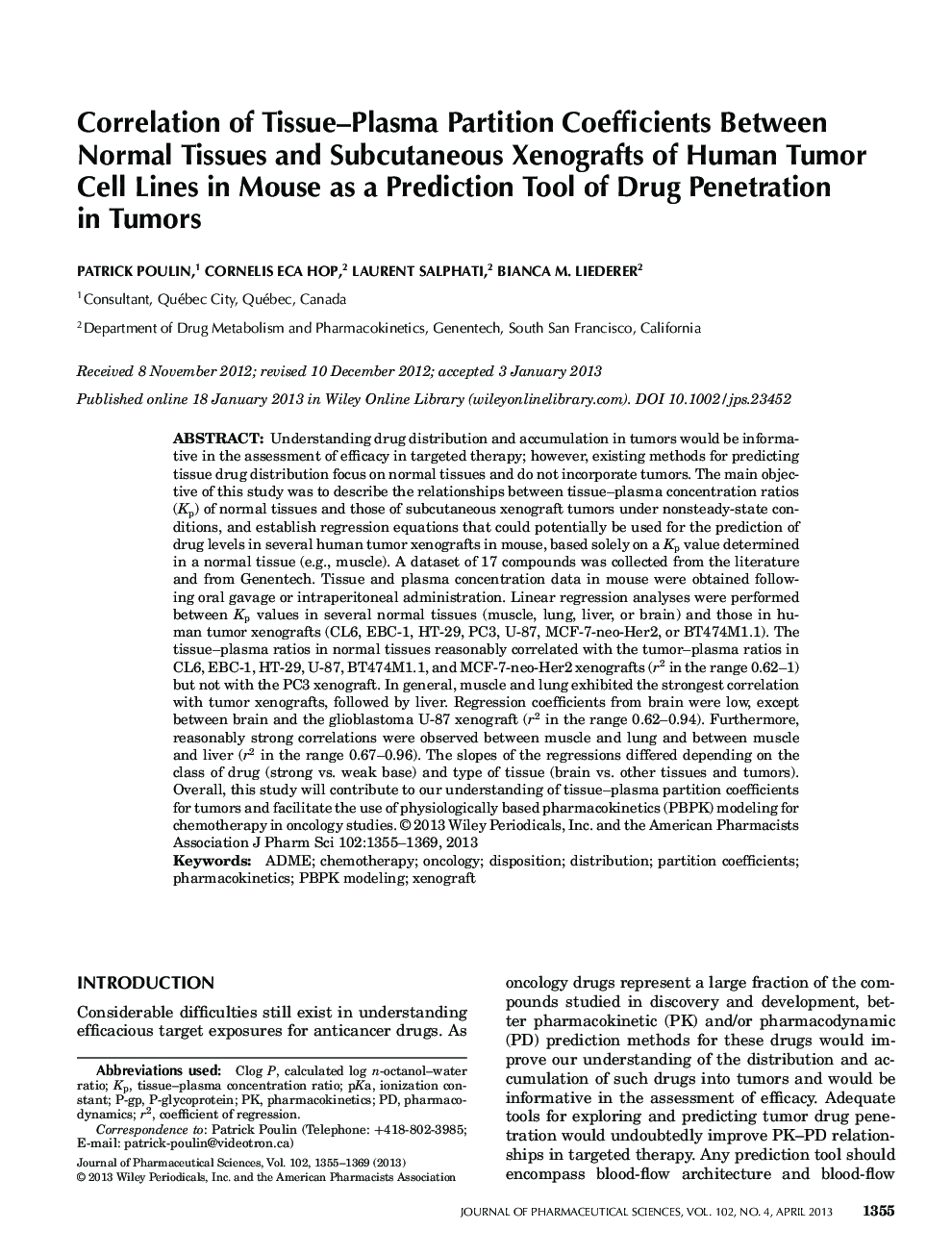| کد مقاله | کد نشریه | سال انتشار | مقاله انگلیسی | نسخه تمام متن |
|---|---|---|---|---|
| 2485186 | 1114347 | 2013 | 15 صفحه PDF | دانلود رایگان |
عنوان انگلیسی مقاله ISI
Correlation of Tissue-Plasma Partition Coefficients Between Normal Tissues and Subcutaneous Xenografts of Human Tumor Cell Lines in Mouse as a Prediction Tool of Drug Penetration in Tumors
دانلود مقاله + سفارش ترجمه
دانلود مقاله ISI انگلیسی
رایگان برای ایرانیان
کلمات کلیدی
موضوعات مرتبط
علوم پزشکی و سلامت
داروسازی، سم شناسی و علوم دارویی
اکتشاف دارویی
پیش نمایش صفحه اول مقاله

چکیده انگلیسی
Understanding drug distribution and accumulation in tumors would be informative in the assessment of efficacy in targeted therapy; however, existing methods for predicting tissue drug distribution focus on normal tissues and do not incorporate tumors. The main objective of this study was to describe the relationships between tissue-plasma concentration ratios (Kp) of normal tissues and those of subcutaneous xenograft tumors under nonsteady-state conditions, and establish regression equations that could potentially be used for the prediction of drug levels in several human tumor xenografts in mouse, based solely on a Kp value determined in a normal tissue (e.g., muscle). A dataset of 17 compounds was collected from the literature and from Genentech. Tissue and plasma concentration data in mouse were obtained following oral gavage or intraperitoneal administration. Linear regression analyses were performed between Kp values in several normal tissues (muscle, lung, liver, or brain) and those in human tumor xenografts (CL6, EBC-1, HT-29, PC3, U-87, MCF-7-neo-Her2, or BT474M1.1). The tissue-plasma ratios in normal tissues reasonably correlated with the tumor-plasma ratios in CL6, EBC-1, HT-29, U-87, BT474M1.1, and MCF-7-neo-Her2 xenografts (r2 in the range 0.62-1) but not with the PC3 xenograft. In general, muscle and lung exhibited the strongest correlation with tumor xenografts, followed by liver. Regression coefficients from brain were low, except between brain and the glioblastoma U-87 xenograft (r2 in the range 0.62-0.94). Furthermore, reasonably strong correlations were observed between muscle and lung and between muscle and liver (r2 in the range 0.67-0.96). The slopes of the regressions differed depending on the class of drug (strong vs. weak base) and type of tissue (brain vs. other tissues and tumors). Overall, this study will contribute to our understanding of tissue-plasma partition coefficients for tumors and facilitate the use of physiologically based pharmacokinetics (PBPK) modeling for chemotherapy in oncology studies.
ناشر
Database: Elsevier - ScienceDirect (ساینس دایرکت)
Journal: Journal of Pharmaceutical Sciences - Volume 102, Issue 4, April 2013, Pages 1355-1369
Journal: Journal of Pharmaceutical Sciences - Volume 102, Issue 4, April 2013, Pages 1355-1369
نویسندگان
Patrick Poulin, Cornelis Eca Hop, Laurent Salphati, Bianca M. Liederer,